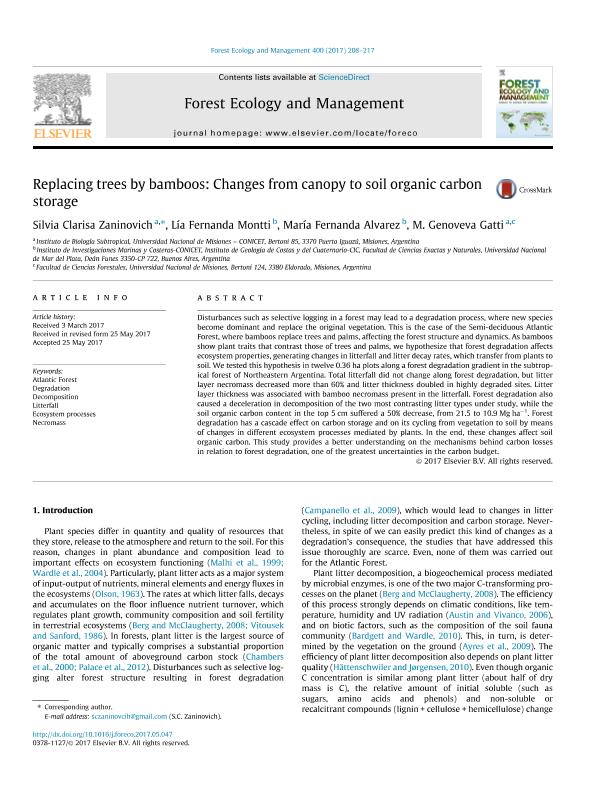Artículo
Replacing trees by bamboos: Changes from canopy to soil organic carbon storage
Fecha de publicación:
06/2017
Editorial:
Elsevier Science
Revista:
Forest Ecology and Management
ISSN:
0378-1127
Idioma:
Inglés
Tipo de recurso:
Artículo publicado
Clasificación temática:
Resumen
Disturbances such as selective logging in a forest may lead to a degradation process, where new species become dominant and replace the original vegetation. This is the case of the Semi-deciduous Atlantic Forest, where bamboos replace trees and palms, affecting the forest structure and dynamics. As bamboos show plant traits that contrast those of trees and palms, we hypothesize that forest degradation affects ecosystem properties, generating changes in litterfall and litter decay rates, which transfer from plants to soil. We tested this hypothesis in twelve 0.36 ha plots along a forest degradation gradient in the subtropical forest of Northeastern Argentina. Total litterfall did not change along forest degradation, but litter layer necromass decreased more than 60% and litter thickness doubled in highly degraded sites. Litter layer thickness was associated with bamboo necromass present in the litterfall. Forest degradation also caused a deceleration in decomposition of the two most contrasting litter types under study, while the soil organic carbon content in the top 5 cm suffered a 50% decrease, from 21.5 to 10.9 Mg ha−1. Forest degradation has a cascade effect on carbon storage and on its cycling from vegetation to soil by means of changes in different ecosystem processes mediated by plants. In the end, these changes affect soil organic carbon. This study provides a better understanding on the mechanisms behind carbon losses in relation to forest degradation, one of the greatest uncertainties in the carbon budget.
Palabras clave:
Atlantic Forest
,
Degradation
,
Descomposition
,
Litterfall
Archivos asociados
Licencia
Identificadores
Colecciones
Articulos(IBS)
Articulos de INSTITUTO DE BIOLOGIA SUBTROPICAL
Articulos de INSTITUTO DE BIOLOGIA SUBTROPICAL
Citación
Zaninovich, Silvia Clarisa; Montti, Lia Fernanda; Alvarez, Maria Fernanda; Gatti, Maria Genoveva; Replacing trees by bamboos: Changes from canopy to soil organic carbon storage; Elsevier Science; Forest Ecology and Management; 400; 6-2017; 208-217
Compartir
Altmétricas




